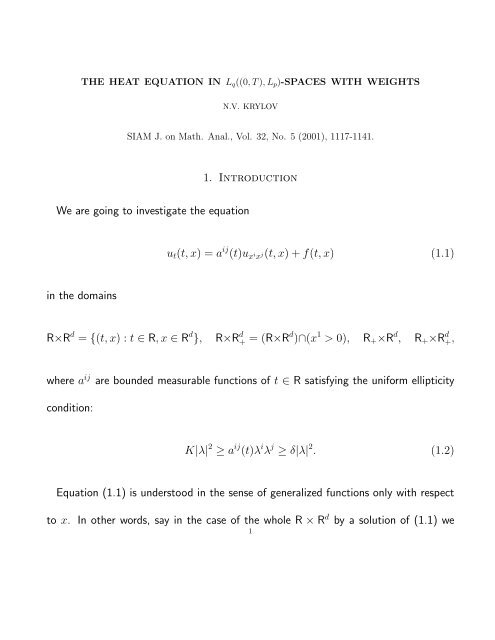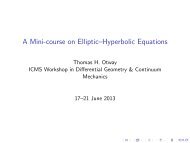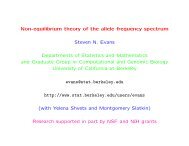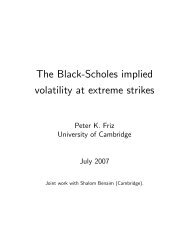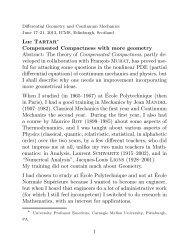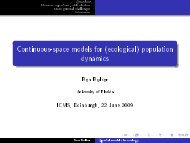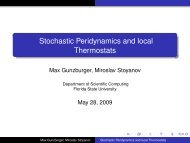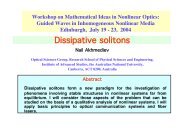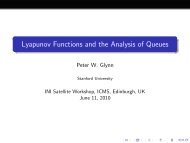1. Introduction We are going to investigate the equation ut(t, x ... - ICMS
1. Introduction We are going to investigate the equation ut(t, x ... - ICMS
1. Introduction We are going to investigate the equation ut(t, x ... - ICMS
- No tags were found...
You also want an ePaper? Increase the reach of your titles
YUMPU automatically turns print PDFs into web optimized ePapers that Google loves.
THE HEAT EQUATION IN L q ((0,T),L p )-SPACES WITH WEIGHTSN.V. KRYLOVSIAM J. on Math. Anal., Vol. 32, No. 5 (2001), 1117-114<strong>1.</strong><strong>1.</strong> <strong>Introduction</strong><strong>We</strong> <strong>are</strong> <strong>going</strong> <strong>to</strong> <strong>investigate</strong> <strong>the</strong> <strong>equation</strong>u t (t, x) =a ij (t)u xi xj(t, x)+f(t, x) (<strong>1.</strong>1)in <strong>the</strong> domainsR×R d = {(t, x) :t ∈ R,x∈ R d }, R×R d + =(R×R d )∩(x 1 > 0), R + ×R d , R + ×R d +,where a ij <strong>are</strong> bounded measurable functions of t ∈ R satisfying <strong>the</strong> uniform ellipticitycondition:K|λ| 2 ≥ a ij (t)λ i λ j ≥ δ|λ| 2 . (<strong>1.</strong>2)Equation (<strong>1.</strong>1) is unders<strong>to</strong>od in <strong>the</strong> sense of generalized functions only with respect<strong>to</strong> x. In o<strong>the</strong>r words, say in <strong>the</strong> case of <strong>the</strong> whole R × R d by a sol<strong>ut</strong>ion of (<strong>1.</strong>1) we1
2mean a function u(t), t ∈ R, taking values in <strong>the</strong> set of generalized functions on R dsuch that, for any t, s ∈ R satisfying t ≥ s and test function ϕ ∈ C ∞ 0 (R d ),wehave(u(t),ϕ)=(u(s),ϕ)+∫ ts[a ij (r)(u(r),ϕ xi xj)+(f(r),ϕ)] dr.The emphasis is on proving solvability in function spaces of Sobolev type with differentpowers of summability p and q with respect <strong>to</strong> x and t. This issue arose from <strong>the</strong> <strong>the</strong>oryof s<strong>to</strong>chastic partial differential <strong>equation</strong>s in domains in Sobolev spaces with weightsand it turns o<strong>ut</strong> that, in this <strong>the</strong>ory, <strong>the</strong> spaces with weights <strong>are</strong> <strong>the</strong> only reasonableones where <strong>to</strong> look for sol<strong>ut</strong>ions <strong>to</strong> <strong>equation</strong>s in domains. To illustrate this necessityconsideru t = u xx in R 2 + with u(0,x)=0,u(t, 0) = g(t),where g is a bounded nondifferentiable function. Thenu xx cannot be continuous sinceo<strong>the</strong>rwise0=u(t, 0) − u(0, 0) = g(t) − g(0) =∫ t0u xx (s, 0) ds.This <strong>equation</strong> arrises from <strong>the</strong> SPDEu(t, x) − u(0,x)=∫ t0u xx (s, x) ds + w t ,where w t is a one-dimensional Wiener process. Hence comes <strong>the</strong> need of weights.
Next, <strong>equation</strong> (<strong>1.</strong>1) will be considered in L q ((0,T),L p )-spaces, so that <strong>the</strong> powersof summability with respect <strong>to</strong> x and t <strong>are</strong> different.Surprisingly enough, <strong>to</strong> <strong>the</strong> best of my knowledge, <strong>the</strong> case q ≠ p was never addressed3before even for <strong>the</strong> heat <strong>equation</strong> in R × R d witho<strong>ut</strong> weights.<strong>We</strong> could only findreferences [1] and [12], where different powers of summability can be related <strong>to</strong> <strong>the</strong>Cauchy problem in {t >0} for f =0. It turns o<strong>ut</strong> that in R × R d <strong>the</strong> result we needcan be obtained quite easily on <strong>the</strong> basis of a Banach space version of <strong>the</strong> Calderón-Zygmund <strong>the</strong>orem (see Sec. 2), which allows one <strong>to</strong> pass from q = p <strong>to</strong> q ≠ p.For <strong>equation</strong> (<strong>1.</strong>1) in R×R d + we impose zero boundary condition and look for sol<strong>ut</strong>ionsin weighted Sobolev spaces with weights allowing <strong>the</strong> spatial derivatives of sol<strong>ut</strong>ions <strong>to</strong>blow up near <strong>the</strong> boundary x 1 =0. Our results in this setting extend <strong>the</strong> correspondingresults in [5], where q = p.This time we again use <strong>the</strong> Calderón-Zygmund <strong>the</strong>orem starting with <strong>the</strong> results validfor q = p. However, in order <strong>to</strong> check <strong>the</strong> conditions of this <strong>the</strong>orem, we need somenontrivial properties of <strong>the</strong> heat semigroup in weighted spaces, which we prove in Sec. 4.In Sec. 5, this allow us <strong>to</strong> get <strong>the</strong> result for R×R d +, b<strong>ut</strong> only if a 1j ≡ 0 for j ≥ 2. Usually,if one proves a sufficiently strong result for <strong>the</strong> heat <strong>equation</strong>, <strong>the</strong> same or very close
4result can be proved for <strong>equation</strong>s with variable continuous coefficients. However, in<strong>the</strong> main application, which we have in mind, <strong>to</strong> s<strong>to</strong>chastic partial differential <strong>equation</strong>sfrom filtering <strong>the</strong>ory, <strong>the</strong> regularity of a ij in time is hard <strong>to</strong> control. Therefore, wealways deal only with measurable coefficients and, in Sec. 6 after some additional work,we prove our main result for <strong>equation</strong>s in R × R d +in full generality.The arguments of Sec. 6 <strong>are</strong> based on Lemma 2.5, which also allows us <strong>to</strong> give adifferent proof of <strong>the</strong> result in R × R d by using <strong>the</strong> Marcinkiewicz interpolation <strong>the</strong>oremra<strong>the</strong>r than <strong>the</strong> Calderón-Zygmund <strong>the</strong>orem.The proofs of part of <strong>the</strong> results <strong>are</strong> based on a general <strong>the</strong>orem saying, roughlyspeaking that, whatever estimate is true for <strong>the</strong> heat <strong>equation</strong>, it is also true for parabolic<strong>equation</strong>s with coefficients depending only on time. This <strong>the</strong>orem is equally applicable<strong>to</strong> Sobolev and Hölder spaces.Finally, it is worth noting that we also give results for <strong>the</strong> initial value problems. Togive <strong>the</strong> reader a flavor of our results in R×R d + we state a particular case of Theorem 5.2.
Theorem <strong>1.</strong><strong>1.</strong> Let p, q ∈ (1, ∞), −1
6This allows us <strong>to</strong> reduce estimating <strong>the</strong> L np (L p )-norm of u(t, x) <strong>to</strong> estimating L p -normof <strong>the</strong> function u(t, x 1 ) · ... · u(t, x n ) which happens <strong>to</strong> satisfy <strong>the</strong> heat <strong>equation</strong> in ahigher dimension space. It turns o<strong>ut</strong> that this device works equally well for s<strong>to</strong>chasticpartial differential <strong>equation</strong>s.DefineLu = a ij u xi x j − u t, (2.1)L p = L p (R d ), H γ p =(1− ∆)−γ/2 L p , H γ,qp = L q (R,H γ p ),H γ,qp (T )=L q((0,T),H γ p ), Lq p = H0,q p , Lq p(T )=H0,q p(T ).It is well known that, for any s ∈ Randf ∈ C ∞ 0 (R d ), <strong>the</strong>re exists a unique boundedcontinuous function u(t, x) on [s, ∞) × R d satisfying Lu(t) =0for t>swith initialcondition u(s) =f. <strong>We</strong>denoteu(t) =T s,t fand recall that, for each s and t, <strong>the</strong>opera<strong>to</strong>rT s,t is written as <strong>the</strong> convol<strong>ut</strong>ion of fwith a Gaussian density. In particular, T s,t f is infinitely differentiable in x. Finally, forf ∈ C ∞ 0 (R × R d ),letRf(t) :=∫ t−∞T s,t f(s) ds,Af := D 2 Rf.
7Also remember that, for f ∈ C ∞ 0 (R × Rd ), <strong>the</strong> function Rf satisfiesLRf = −f.Theorem 2.<strong>1.</strong> Let q, p ∈ (1, ∞), γ ∈ R.Then <strong>the</strong> opera<strong>to</strong>r A is uniquely extendible<strong>to</strong> a bounded opera<strong>to</strong>r acting in H γ,qp . If we keep <strong>the</strong> same notation for <strong>the</strong>extension, <strong>the</strong>n||D 2 Rf|| Hγ,qp≤ N(δ, d, q, p)||f|| Hγ,qp . (2.2)Let us emphasize that <strong>the</strong> constant N in (2.2) is independent of K (see (<strong>1.</strong>2)).The following is a corollary of Theorem 2.<strong>1.</strong>Theorem 2.2. Let q, p ∈ (1, ∞), T ∈ (0, ∞), and γ ∈ R. Take ε>0, f ∈ H γ,qp (T )and u 0 ∈ H γ+2−2/q+εp. Then in H γ+2,q (T ) <strong>the</strong>re is a unique sol<strong>ut</strong>ion of (<strong>1.</strong>1) with<strong>the</strong> initial condition u(0) = u 0 . For this sol<strong>ut</strong>ionp||u xx || Hγ,qp(T ) ≤ N(||f|| Hγ,qp(T ) + ||u 0 || γ+2−2/q+εH), (2.3)pwhere N = N(δ, d, q, p, T, ε), and if u 0 =0, <strong>the</strong>n N is independent of T . Finally,if q = p, one can take ε =0.
8The following corollary of Theorem 2.2 is obtained by odd continuation of <strong>the</strong> functionsinvolved.Corollary 2.3. All assertions of Theorem 2.2 hold true for γ =0if we replace R dwith R d + everywhere, assume that a 1j ≡ 0 for j =2, ..., d, and supplement <strong>equation</strong>(<strong>1.</strong>1) with zero boundary condition at x 1 =0.To prove Theorem 2.1, we use <strong>the</strong> following Banach space version of <strong>the</strong> Calderón-Zygmund <strong>the</strong>orem. This a standard result which is discussed, for instance, in Chapter1 of [10] and can be extracted from more general results of [1]. For a Hilbert spaceversion of this <strong>the</strong>orem in <strong>the</strong> form of multipliers along with a version of Theorem 2.1for q = p and different opera<strong>to</strong>rs L we refer <strong>the</strong> reader <strong>to</strong> [9].Theorem 2.4. Let F and G be Banach spaces, p ∈ (1, ∞), and A : L p (R n ,F) →L p (R n ,G) be a linear bounded opera<strong>to</strong>r. Assume that if a bounded strongly measurableF -valued function f has compact support Γ, <strong>the</strong>n, for almost any x ∉ Γ, wehave∫Af(x) = K(x, y)f(y) dy,R n
where K(x, y) is a bounded opera<strong>to</strong>r from F in<strong>to</strong> G, defined for x ≠ y, stronglymeasurable with respect <strong>to</strong> y with norm bounded in y o<strong>ut</strong>side any neighborhood of x.Also assume that K(x, y) is strongly measurable with respect <strong>to</strong> x and <strong>the</strong>re existsa constant N such that∫|K(x, y) − K(x, z)| dx ≤ N|x−y|>2|y−z|for any y and z, which holds, for instance, if K(x, y) is weakly differentiable in yand|∇ y K(x, y)| ≤N|x − y| −d−1 .9Then <strong>the</strong> opera<strong>to</strong>r A is uniquely extendible <strong>to</strong> a bounded opera<strong>to</strong>r from L q (R n ,F)<strong>to</strong> L q (R n ,G) for any q ∈ (1,p] and A is of weak-type (1, 1) on bounded functionswith compact support.The first proof of Theorem 2.<strong>1.</strong>In [3] a general <strong>the</strong>orem is proved whichroughly speaking says that, whatever estimate is true for <strong>the</strong> heat <strong>equation</strong> in translationinvariant spaces, it is also true with <strong>the</strong> same constant for <strong>equation</strong> (<strong>1.</strong>1) with <strong>the</strong>coefficients depending only on t provided(a ij (t)) ≥ (δ ij ).
10Therefore we may and will assume that a ij ≡ δ ij . Also assuming γ =0does notrestrict generality.Now we <strong>are</strong> ready <strong>to</strong> use Theorem 2.4. From Sec. 4.3 of [8] we know that A isuniquely defined and is bounded as an opera<strong>to</strong>r acting in L p (R,L p ). <strong>We</strong> <strong>are</strong> <strong>going</strong> <strong>to</strong>check that A satisfies <strong>the</strong> assumptions of Theorem 2.4 with F = G = L p .Observe <strong>the</strong> simple fact that, for t>0, k =1, 2, ..., andf ∈ L p ,wehave∂T t f/∂t =∆T t f and ||∂ k T t f/∂t k || Lp ≤ Nt −k ||f|| Lp ,where N depends only on d and k. Fort>0 introduce <strong>the</strong> opera<strong>to</strong>rK(t) =∆T t : L p → L pwith norm bounded by Nt −1 ,whereN is independent of t. Fort ≤ 0, letK(t) =0.Since a ij = δ ij ,wehaveRf(t, x) =∫ t−∞T t−s f(s, ·)(x) ds.In addition, if t is at a distance from <strong>the</strong> support of f, <strong>the</strong>n differentiating <strong>the</strong> aboveformula presents no difficulties and we findAf(t, x) =∫ t−∞∆T t−s f(s, ·) dx =∫RK(t − s)f(s)(x) ds.
In order <strong>to</strong> prove that <strong>the</strong> assumptions of Theorem 2.4 <strong>are</strong> satisfied, it only remains <strong>to</strong>use11||∂K(t − s)f/∂s|| Lp = ||∂ 2 T t−s f/∂s 2 || Lp I t>s ≤ N|t − s| −2 ||f|| Lp .By Theorem 2.4, A is well defined and bounded as an opera<strong>to</strong>r from L q (R,L p ) in<strong>to</strong>itself for 1
12by using self similarity. In almost <strong>the</strong> same form as stated this lemma is proved inAppendix in [11].In <strong>the</strong> next lemma we do <strong>the</strong> first step <strong>to</strong> considering <strong>the</strong> power of summability in tequal <strong>to</strong> multiples of p.Lemma 2.6. Let T ≤∞, p ∈ (1, ∞), n =1, 2, .... For k =1, ..., n, let u k∈H 2,pp (T ) be sol<strong>ut</strong>ions of <strong>the</strong> <strong>equation</strong>u k t = aij u k x i x j + f kwith zero initial data and with f k ∈ L p p (T ). Then∫ T0n∏||∆u k (t)|| p L pdt ≤ Nk=1n∑∫ Tk=10∏||f k (t)|| p L p||∆u j (t)|| p L pdt, (2.4)j≠kwhere N = N(n, d, p, δ).Proof. Define v k =∆u k .ForX =(x 1 , ..., x n ) ∈ R nd with x i ∈ R d ,defineV (t, X) =v 1 (t, x 1 ) · ... · v n (t, x n ).Observe thatV t (t, X) =LV (t, X)+F (t, X),
where LV = a rs (V xr1 x s 1 + ... + V x r nx s n ),13F (t, X) =∆ xi G i (t, X),G i (t, X) =f i (t, x i ) ∏ j≠iv j (t, x j ).Hence by Lemma 2.5||V || Lp ((0,T )×R nd ) ≤ N ∑ i||G i || Lp ((0,T )×R nd )and this is exactly (2.4). The lemma is proved.The second proof of Theorem 2.<strong>1.</strong>As in <strong>the</strong> first proof, we only have <strong>to</strong>consider <strong>the</strong> case a ij ≡ δ ij and γ =0. Also obviously it suffices <strong>to</strong> prove (2.2) forf ∈ C ∞ 0 (R × Rd ). Witho<strong>ut</strong> loss of generality we assume that f(t) =0for t ≤ 0.Let u = Rf. Thenu is a classical sol<strong>ut</strong>ion ofu t =∆u + ffor t>0 with zero initial condition and, even more than that, u(s) =0for s ≤ 0. Inaddition, it is easy <strong>to</strong> check that u ∈ L p ((0,T),H 2 p) for each T
14which by Hölder’s inequality yields ||u xx || Lnp ((0,T ),L p ) ≤ N||f|| Lnp ((0,T ),L p ). By lettingT →∞we obtain (2.2).To treat general q ≥ p, it suffices <strong>to</strong> use <strong>the</strong> Marcinkiewicz interpolation <strong>the</strong>orem.As in <strong>the</strong> first proof, <strong>the</strong> case q ≤ p is considered by duality. The <strong>the</strong>orem is proved.3. Sobolev spaces with weightsM α is <strong>the</strong> opera<strong>to</strong>r of multiplying by (x 1 ) α , M = M 1 .D(R d +) <strong>the</strong> space of all distrib<strong>ut</strong>ions on R d +.L p,θ := H 0 p,θ = L p (R d +, (x 1 ) θ−d dx).If γ is a nonnegative integer, <strong>the</strong> space H γ p,θ is{u : u, x 1 u x ,... ,(x 1 ) |α| D α u ∈ L p,θ ∀α : |α| ≤γ}.For negative γ one may use duality and for all o<strong>the</strong>r γ <strong>the</strong> complex interpolation.One may think that it is natural <strong>to</strong> replace (x 1 ) |α| with (x 1 ) α 1 ...
Definition 3.<strong>1.</strong> Take and fix a nonnegative function ζ ∈ C ∞ 0 (R + ) such15that∞∑n=−∞ζ p (e x−n ) ≥ 1 ∀x ∈ R.For γ,θ ∈ R, and p ∈ (1, ∞) let H γ p,θbe <strong>the</strong> set of all distrib<strong>ut</strong>ions uon R d + such that||u|| p H γ p,θ∞∑:= e nθ ||u(e n ·)ζ|| p H < ∞.p γn=−∞Independence of ζ...The space C ∞ 0 (Rd + ) is dense in Hγ p,θ .Theorem 3.2. (i) For any a>0 and α ∈ R,||u(a ·)|| p H γ p,θ≤ a −θ N||u|| p H γ p,θ≤ N||u(a ·)|| p H γ p,θ,||M α u|| Hγp,θ ≤ N||u|| H γ p,θ+pα ≤ N||M α u|| Hγp,θ ,||MDu|| Hγ + ||DMu|| p,θH γ ≤ N||u|| p,θ H γ+1 .p,θ(ii) If M −1 u ∈ H γ p,θand θ ≠ d − 1,d− 1+p, <strong>the</strong>n||MD 2 u|| Hγ−2p,θ≤ N||M −1 u|| Hγ ≤ N||MD2 u||p,θ Hγ−2. (3.1)p,θ
16(iii) Let µ ≤ γ and q ≥ p be such thatγ − d/p = µ − d/q.Denoteτ = θq/p(so that τ/q = θ/p). Then for any u ∈ H γ p,θwe haveu ∈ H µ q,τ, ||u|| Hµq,τ≤ N||u|| Hγp,θ .(iv) Assume γp > d and represent γ − d/p as k + ε, where k is aninteger and ε ∈ (0, 1]. Leti, j be multi–indices such that |i| ≤k, |j| = k.Then for any u ∈ H γ p,θ ,wehaveM |i|+θ/p D i u ∈ C(R d +), M k+ε+θ/p D j u ∈C ε loc(R d +),||M |i|+θ/p D i u|| C(Rd+ ) ≤ N||u|| γ,p,θ ,[M k+ε+θ/p D j u] Cε (R d +) ≤ N||u|| γ,p,θ ,where C ε (R d + ) is <strong>the</strong> Zygmund space (coinciding with Cε (R d + ) if ε ∈ (0, 1)).
Theorem 3.3. (i) <strong>We</strong> have17(H γ p,θ )′ = H γ′p ′ ,θ ′ , γ ′ = −γ, 1/p +1/p ′ =1, θ/p+ θ ′ /p ′ = d.(ii) For κ ∈ (0, 1), p ∈ (1, ∞), γ i ,θ i ∈ R, i =0, 1,θ = κθ 1 +(1− κ)θ 0 , γ = κγ 1 +(1− κ)γ 0 ,we have [H γ 0p,θ 0,H γ 1p,θ 1] κ = H γ p,θ .For constant b, c defineL b,c = M 2 ∆+bMD 1 − c.It turns o<strong>ut</strong> that <strong>the</strong> fractional powers of <strong>the</strong> degenerate opera<strong>to</strong>r −L b,c can be definedandH γ p,θ =(−L b,c) −γ/2 L p,θ .
18Theorem 3.4. For any γ,ν,p,θ,b, <strong>the</strong>re exist a constant c 0 > 0 suchthat, for any c ≥ c 0 , <strong>the</strong> opera<strong>to</strong>r(−L b,c ) γ : H 2γ+νp,θ→ H ν p,θis bounded and, for any u ∈ H γ+νp,θ,wehave||u|| 2γ+ν,p,θ ≤ N||(−L b,c ) γ u|| ν,p,θ ≤ N||u|| 2γ+ν,p,θ . (3.2)The main difficulty of <strong>the</strong> <strong>the</strong>ory is that ∆ and L b,c do not comm<strong>ut</strong>e.Theorem 3.5. For any b, γ, p, and θ, <strong>the</strong> opera<strong>to</strong>r L b,0 is <strong>the</strong> genera<strong>to</strong>rof an analytic semigroup T bt acting in H γ p,θ .Notice that, if d =1, <strong>the</strong> <strong>the</strong>orem is quite simple. Indeed,(D 2 +(b − 1)D)(v(e x )) = (L b,0 v)(e x ),so that <strong>the</strong> properties of <strong>the</strong> semigroup related <strong>to</strong> L b,0 can be easily obtained from <strong>the</strong>well-known properties of <strong>the</strong> semigroup related <strong>to</strong> <strong>the</strong> opera<strong>to</strong>r D 2 +(b − 1)D withconstant coefficients. However, for d ≥ 2, we do not know any easy way <strong>to</strong> deal withL b,0 .
194. Some smoothing properties of <strong>the</strong> heat semigroup in spaces H γ p,θLetD 2 = D 2lx 1D2−2l x ′be a second order derivative opera<strong>to</strong>r, where l ∈{0, 1}, D 2lx 1is <strong>the</strong> opera<strong>to</strong>r of taking2l derivative in x 1 ,andD 2−2lx ′ is an (2 − 2l)th derivative with respect <strong>to</strong> x ′ .Denote by ˜T t <strong>the</strong> semigroup associated with <strong>the</strong> opera<strong>to</strong>r ∆ in R d + with zero boundarycondition on {x 1 =0}.The following is a corollary of a general <strong>the</strong>orem, which shows that <strong>the</strong> sol<strong>ut</strong>ions of<strong>the</strong> Cauchy problem for <strong>equation</strong> (<strong>1.</strong>1) <strong>are</strong> “naturally smoo<strong>the</strong>r” than <strong>the</strong> initial data.This result interesting in its own right plays a central role in Sec. 5 in proving solvabilityof parabolic <strong>equation</strong>s in weighted spaces.For t ≥ s introduce <strong>the</strong> opera<strong>to</strong>r ˜T s,t so that, for f ∈ C ∞ 0 (Rd + ), ˜T s,t f is <strong>the</strong> sol<strong>ut</strong>ionof <strong>the</strong> <strong>equation</strong>u t (t, x) =a ij (t)u xi xj(t, x)for t>sand x ∈ R d + satisfying u(s, x) =f(x) with zero boundary condition at x 1 =0.One has a very well known representation of <strong>the</strong> kernel of ˜T s,t as <strong>the</strong> difference of certainGaussian densities.
22in our range of θ.<strong>the</strong>orem forTherefore, instead of consideringĀ = M∆ ˜RM −1 f.Ã we may and will prove <strong>the</strong>Notice that, if f ∈ C ∞ 0 (R × Rd ) and t is not in <strong>the</strong> support of f(s) as a function of s,<strong>the</strong>n ˜T s,t M −1 f(s) is infinitely differentiable in x andĀf(t) =M∆ ˜RM −1 f(t) =∫ t−∞M∆ ˜T s,t M −1 f(s) ds. (5.3)Moreover, <strong>the</strong> boundedness of Ā as an opera<strong>to</strong>r from L p (R,H γ p,θ ) <strong>to</strong> L p(R,H γ p,θ ) andpoinwise estimates of <strong>the</strong> opera<strong>to</strong>r M∆ ˜T s,t M −1 show that (5.3) holds for almost all <strong>to</strong><strong>ut</strong>side <strong>the</strong> support of f if f is a bounded H γ p,θ-valued function with compact support.In o<strong>the</strong>r words, for those t,∫Āf(t) =RK(t, s)f(s) ds,where <strong>the</strong> opera<strong>to</strong>r K(t, s) is defined by <strong>the</strong> formulaK(t, s)h = I t>s M∆ ˜T s,t M −1 h.Observe that by a general <strong>the</strong>orem, K(t, s) is a bounded opera<strong>to</strong>r from H γ p,θin<strong>to</strong> itselfwith norm less than N|t − s| −1 .
Now we claim that Ā is a bounded opera<strong>to</strong>r from L q (R,H γ p,θ ) <strong>to</strong> L q(R,H γ p,θ ) for1
24Theorem 5.2. Let p, q ∈ (1, ∞), T ∈ (0, ∞), γ ∈ R,d − 1
Proof. Clearly (6.1) becomes stronger if ν decreases. Therefore we may assume thatν = γ − k, wherek is an integer, and bearing in mind an obvious induction, we seethat, witho<strong>ut</strong> loss of generality, we may let ν = γ − <strong>1.</strong>Now notice that25||M −1 u|| npH γ,npp,θ∫=R∫||M −1 u(t)|| np dt ≤ N ||u(t)|| np dtH γ p,θH γ p,θ−pR∞∑∫ n∏= Ne (θ−p)¯m ||u(t, e mi ·)ζ|| p Hp γm 1 ,...,m n =−∞Ri=1dt, (6.2)with ¯m := m 1 + ... + m n .Here||u(t, e m ·)ζ|| p H γ p≤ N||∆[u(t, em ·)ζ]|| p H γ−2p= ||(1 − ∆) γ/2−1 ∆[u(t, e m ·)ζ]|| p L p= e m(pγ−d) ||(λ m − ∆) γ/2−1 ∆[u(t)ζ m ]|| p L p,where λ m = e −2m and ζ m (x) =ζ(e −m x). Fur<strong>the</strong>rmore,L(uζ m )= ¯f m , where,¯f m = fζ m +2a ij ζ mx iu xj + ua 11 ζ mx1 x 1,and similarly <strong>to</strong> <strong>the</strong> above comp<strong>ut</strong>ation||(λ m − ∆) γ/2−1 ¯fm (t)|| p L p= e −m(pγ−2p−d) || ¯f m (t, e m ·)|| p .Hpγ−2
26Therefore, by Lemma 2.6, which is obviously valid for R in place of (0,T), foranym 1 , ..., m n ,wehave∫n∏||u(t, e mi ·)ζ|| p H γ p dt ≤ NRi=1∫Rn∑i=1e 2m ip || ¯f mi (t, e mi ·)|| p H γ−2p∏||u(t, e mj ·)ζ|| p H dt.p γj≠iComing back <strong>to</strong> (6.2), we conclude||M −1 u|| npH γ,npp,θ∫≤ NRF (t)||u(t)|| (n−1)pH γ p,θ−pdt,whereF (t) :=∞∑m=−∞e m(θ+p) || ¯f m (t, e m ·)|| p .Hpγ−2Next we use (see [5]) that <strong>the</strong> opera<strong>to</strong>r M β is a bounded opera<strong>to</strong>r from H γ p,θ <strong>to</strong> Hγ p,θ+βpand that M∇ is a bounded opera<strong>to</strong>r from H γ p,θ<strong>to</strong> Hγ−1p,θ. Then we find+N∞∑m=−∞F (t) ≤ N∞∑m=−∞e mθ ||u x (t, e m ·)ζ ′ || p H γ−2p≤ N(||Mf(t)|| p H γ−2p,θe m(θ+p) ||f(t, e m ·)ζ|| p H γ−2p+ N∞∑m=−∞+ ||Mu x (t)|| p H γ−2p,θ−pe m(θ−p) ||u(t, e m ·)ζ ′′ || p H γ−2p+ ||M −1 u(t)|| p )H γ−2p,θ≤ N(||Mf(t)|| p H γ−2p,θ+ ||u(t)|| p )H γ−1p,θ−p
27≤ N(||Mf(t)|| p H γ−2p,θ+ ||M −1 u(t)|| p ).H γ−1p,θThus||M −1 u|| npH γ,npp,θ∫≤ NER(||Mf(t)|| p H γ−2p,θ+ ||M −1 u(t)|| p )||M −1 u(t)|| (n−1)p dt,H γ−1H γ p,θp,θand, <strong>to</strong> get (6.1) for ν = γ − 1, it only remains <strong>to</strong> use Hölder’s inequality. The lemmais proved.Lemma 6.2. Let p, q ∈ (1, ∞), d−1
28[3] N.V. Krylov, A parabolic Littlewood-Paley inequality with applications <strong>to</strong> parabolic <strong>equation</strong>s, Topological Methodsin Nonlinear Analysis, Journal of <strong>the</strong> Juliusz Schauder Center, Vol. 4, No. 2, (1994), 355–364.[4] N.V. Krylov, An analytic approach <strong>to</strong> SPDEs, pp. 185-242 in S<strong>to</strong>chastic Partial Differential Equations: SixPerspectives, Ma<strong>the</strong>matical Surveys and Monographs, Vol. 64, AMS, Providence, RI, 1999.[5] N.V. Krylov, <strong>We</strong>ighted Sobolev spaces and Laplace’s <strong>equation</strong> and <strong>the</strong> heat <strong>equation</strong>s in a half space, ComminPDE, Vol. 24, No. 9-10 (1999), 1611-1653.[6] N.V. Krylov, Some properties of weighted Sobolev spaces in R+, d Annali Scuola Normale Superiore di Pisa, Sci.Fis. Mat. Serie 4, Vol. 28 (1999), Fasc. 4, 675-693.[7] N.V. Krylov, Some properties of traces for s<strong>to</strong>chastic and deterministic parabolic weighted Sobolev spaces, submitted<strong>to</strong>Functional Analysis.[8] O.A. Ladyzhenskaya, V.A. Solonnikov, and N.N. Ural’tceva, “Linear and quasi-linear parabolic <strong>equation</strong>s”,Nauka, Moscow, 1967 in Russian; English translation: American Math. Soc., Providence, 1968.[9] W. Littman, C. McCarthy, and N. Riviere, L p -multiplier <strong>the</strong>orems, Studia Math., Vol. 30 (1968), 193-217.[10] E.M. Stein, “Harmonic analysis: real-variable methods, orthogonality and oscilla<strong>to</strong>ry integrals”, Prince<strong>to</strong>n Univ.Press, Prince<strong>to</strong>n, NJ, 1993.[11] D.W. Stroock and S.R.S. Varadhan, “Multidimensional diffusion processes”, Springer Verlag, Berlin-New York,1979.[12] P. <strong>We</strong>idemaier, On <strong>the</strong> sharp initial trace of functions with derivatives in L p (0,T; L p (Ω)), Bollettino U.M.I. (7),9-B (1995), 321-338.


